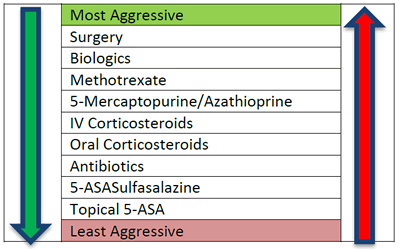Treatment for Crohn’s Disease
Since Crohn's Disease impacts different areas of the bowel and may be more severe in some areas, treatment options may change over time. There are five main categories of medications used to treat Crohn’s Disease:
- Aminosalicylates are given orally or rectally and act to decrease inflammation at the wall of the intestine. Examples: Mesalamine, Balsalazide, Olsalazine, Sulfasalazine
- Corticosteroids affect the body’s ability to begin and maintain an inflammatory process. They are effective for short-term control of flare-ups but are not recommended for long-term or maintenance use because of their side effects. Examples: Glucocorticoids, Prednisone
- Immunomodulators are a class of medication that modifies the activity of the immune system so that it cannot cause ongoing inflammation. Examples: Cyclosporine, Azathioprine, 6-MP, Methotrexate
- Antibiotics may be used for Crohn's Disease when it impacts the colon or the area around the anus.
- Biologic therapies are indicated for people with moderately to severely active disease who have not responded well to conventional therapy. Examples: TNF ACE inhibitors, Infliximab (IV), Adalimumab, Certolizumab, Adhesion molecule inhibitor, Natalizumab
The approach to treatment for Crohn's Disease must be tailored to the individual. Factors that determine the approach to treatment include: disease severity, anatomic location of disease, previous response to medication, side effects of medication and/or comorbidities, other diseases and medical conditions.
Physicians will approach the management of Crohn's Disease, based on their own experiences. Approaches vary across gastroenterologists.
Top down approach: More aggressive drugs such as biologics are used early to reduce the opportunity of progression to a penetrating fistulizing disease.

Bottom up approach: Starts with less aggressive therapy to treat symptoms, moving to stronger drugs when current therapy is no longer effective.
These medications may not adequately control symptoms for everyone with IBD, and some people with these conditions develop complications that require surgery. According to the Crohn’s & Colitis Foundation of America (CCFA), about 70% of people with Crohn's Disease eventually require surgery.
The CCFA goes on to say with medical and/or surgical treatment:
- About 50% of patients will be in remission or have mild disease over the next five years
- 45% of those in remission will remain relapse-free over the next year
- 35% will have one or two relapses
- 11% will have chronically active disease
Next Page: Crohn’s Disease Treatment Goal

